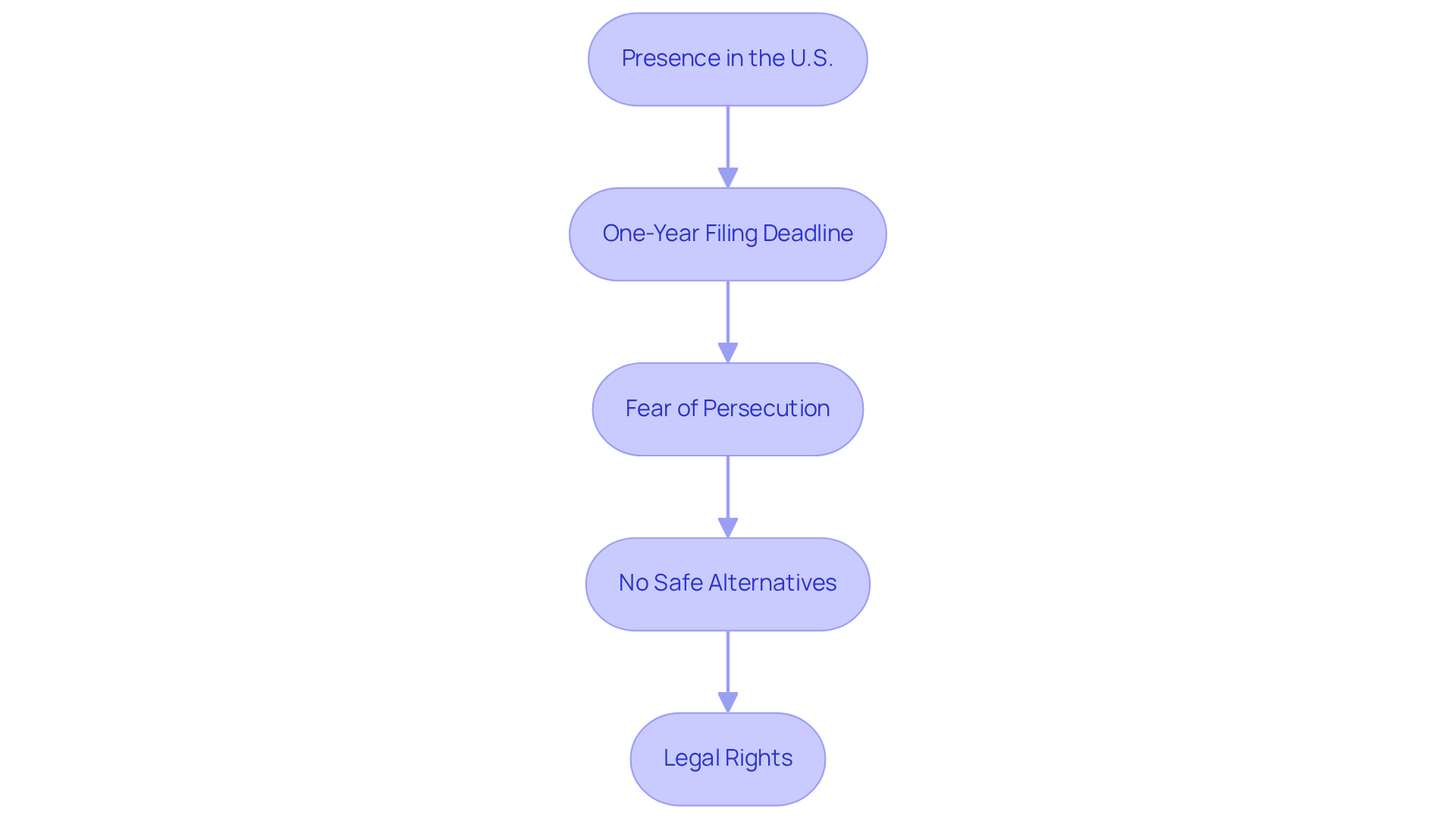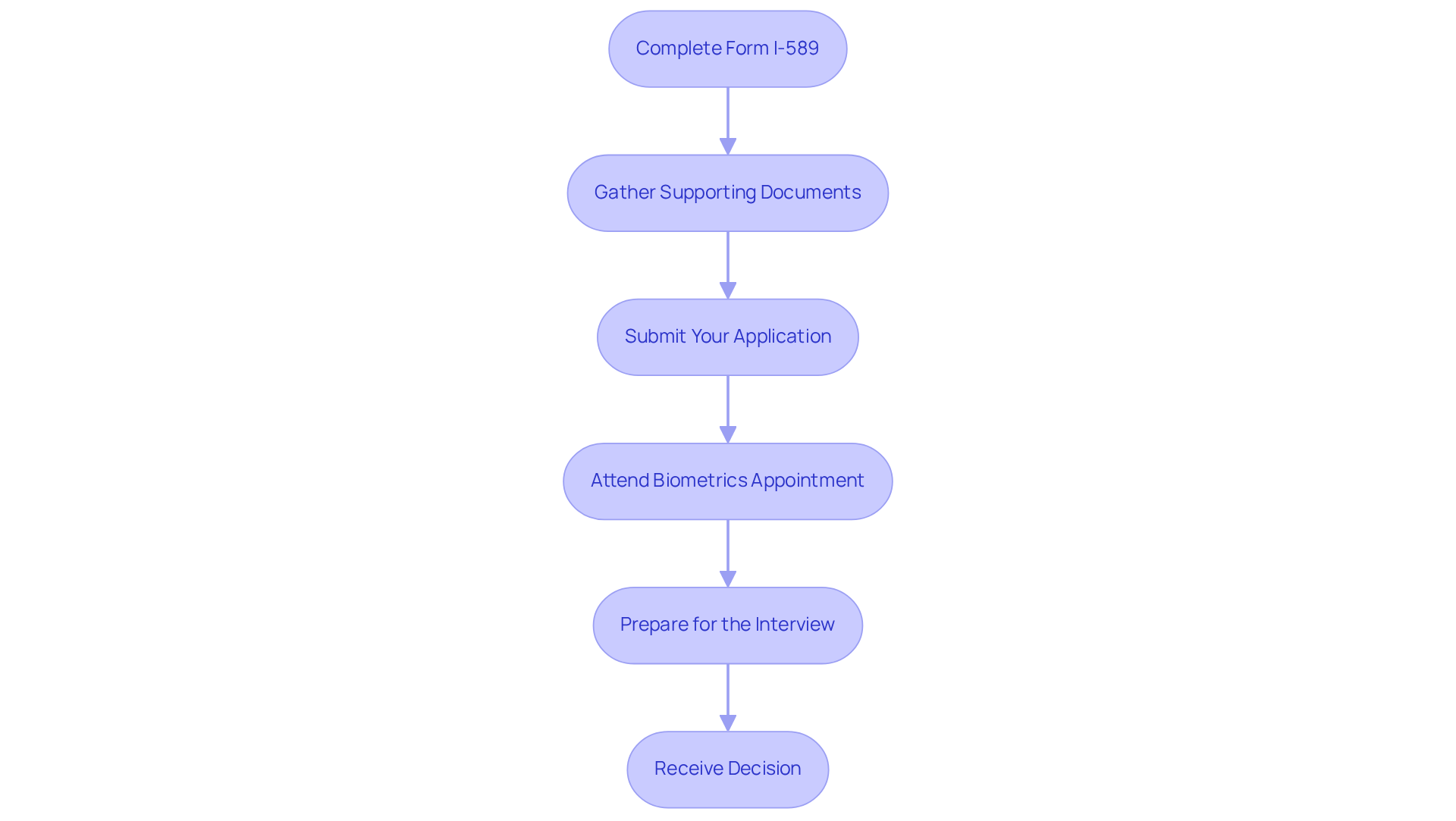Overview
This article is your essential step-by-step guide for immigrant healthcare workers seeking asylum in the United States. It breaks down the definition, eligibility criteria, and application process in clear terms. We understand how overwhelming this journey can feel, with confusing immigration processes and tight deadlines. But you don’t have to navigate this alone.
Knowing your legal rights is crucial. Gathering the necessary documentation can make all the difference in your application. By adhering to deadlines and preparing thoroughly, you increase your chances of a favorable outcome. Remember, we’re in this fight with you.
Have you ever felt lost in the immigration process? You’re not alone. Many face similar challenges, but there are solutions. We’re here to guide you every step of the way, ensuring you understand what’s needed to move forward confidently.
Your future matters to us. We’re committed to fighting for your rights and providing the clarity you need in these moments of crisis. Let’s take this journey together—because you deserve support and guidance as you seek a new beginning. Yo Peleo — We Fight.
Introduction
Navigating the asylum process can feel overwhelming, especially for immigrant healthcare workers who face unique challenges in their quest for safety and stability. This guide provides a clear, step-by-step approach to understanding asylum eligibility, filing applications, and tackling common obstacles.
Have you ever felt lost in the immigration process? What happens when the complexities of legal requirements threaten to derail your journey to protection? Exploring these critical aspects not only empowers you to safeguard your future but also highlights the support systems available during this crucial time.
We understand how daunting this can be. You’re not alone in this fight; we’re here to guide you every step of the way. Your future matters to us, and together, we can navigate these challenges.
Understand Asylum: Definition and Eligibility Criteria
Asylum offers vital protection for those who’ve fled their home country, driven by a genuine fear of persecution due to race, religion, nationality, political opinion, or membership in a specific social group. If you’re seeking asylum in the United States, here’s what you need to know:
- Presence in the U.S.: You must be physically present in the United States or at a port of entry.
- One-Year Filing Deadline: Your asylum application needs to be filed within one year of your arrival in the U.S., unless you qualify for an exception.
- Fear of Persecution: You must show a credible fear of persecution in your home country based on one of the five protected grounds.
- No Safe Alternatives: You need to prove that returning to your home country or relocating within it isn’t safe for you.
Navigating these criteria can be overwhelming. It’s crucial to understand your rights and the immediate steps to take if you face legal challenges, like receiving a subpoena or encountering ICE enforcement. Remember, you have the right to remain silent, the right to an attorney, and the right not to sign documents without legal counsel. If you find yourself in such a situation, don’t hesitate—exercise your right to remain silent and request an attorney right away.
For urgent legal assistance, reach out to Vasquez Law Firm at our emergency line, available 24/7. We operate on a contingency fee basis for personal injury cases, ensuring that financial barriers don’t stop you from seeking the justice you deserve. Understanding these rights and actions is essential for effectively navigating the immigration process and protecting your future.
We’re here to fight for your family. Your future matters to us. Yo Peleo — We Fight.

Follow the Application Process: Step-by-Step Instructions
Applying for asylum can feel overwhelming, but you’re not alone. Here’s a clear guide to help you navigate the process:
-
Complete Form I-589: Start by downloading and filling out Form I-589, the Application for Asylum and for Withholding of Removal. Make sure every section is filled out completely to avoid any delays. As experts from the Asylum Seeker Advocacy Project (ASAP) remind us, "Typically, if you choose to request protection, you must submit your request (Form I-589) within one year of arriving in the United States."
-
Gather Supporting Documents: Next, collect the necessary documents. You’ll need:
- Proof of identity (like a passport or birth certificate)
- Evidence supporting your claim (affidavits, police reports, medical records)
- Country condition reports that show the risk of persecution.
-
Submit Your Application: Once you have everything ready, mail your completed Form I-589 along with your supporting documents to the right USCIS address. Don’t forget to keep copies of everything you send. Remember, your application must be submitted within one year of entering the United States.
-
Attend Biometrics Appointment: After you submit your application, you’ll receive a notice for a biometrics appointment. This is where your fingerprints will be taken, an important step in the process.
-
Prepare for the Interview: You’ll be scheduled for an interview with an asylum officer. Take time to review your submission and practice your testimony. Being well-prepared can make a significant difference in the outcome of your application.
-
Receive Decision: After your interview, you’ll get a decision on your request. If granted, you can stay in the U.S. and may apply for work authorization, usually available after 180 days.
It’s crucial to pay attention to the details throughout this process. Many applicants make mistakes by missing deadlines or submitting incomplete forms. By following these steps carefully, you can simplify your immigration request and boost your chances of success. Remember, we’re here to fight for your family and support you every step of the way.

Overcome Challenges: FAQs and Troubleshooting Tips
Asylum seekers often encounter significant hurdles during their request process. Let’s tackle some common questions and provide practical tips:
-
What if I miss the one-year deadline?
Missing the one-year deadline doesn’t automatically disqualify you from asylum. You might still qualify if you can show changed circumstances in your home country or extraordinary circumstances that prevented timely filing. Many applicants have successfully argued that political upheaval or personal threats arose after they first entered the U.S. -
What should I do if my request is denied?
If your application is denied, you have the right to appeal the decision to the Board of Immigration Appeals (BIA). It’s crucial to seek legal help at this stage. Attorneys can guide you through other options, like applying for withholding of removal or protection under the Convention Against Torture (CAT). In 2025, appeal success rates have shown some improvement, but navigating this system without legal support can be overwhelming. -
How can I prove my fear of persecution?
To back up your fear of persecution, gather credible evidence. This includes witness statements, news articles, and expert opinions that support your claims. Personal testimonies and documentation of threats can significantly bolster your case. -
What if I am detained during the process?
If you find yourself detained, it’s vital to seek legal representation right away. You still have the right to seek refuge, even while in detention, and having a lawyer can ensure your request is handled properly. -
Can I work while my request is pending?
Yes, you can apply for a work permit 150 days after submitting your asylum application, as long as you haven’t caused any delays in the process. This can be a crucial step in maintaining your livelihood while you wait for a decision.
By preparing for these challenges and understanding your rights, you can navigate the asylum process more effectively. Remember, the landscape is changing, and staying informed about policy updates is essential. We’re here to fight for your family and support you every step of the way.

Conclusion
Navigating the asylum process can feel overwhelming, especially for immigrant healthcare workers seeking safety and stability in the United States. It’s crucial to understand the eligibility criteria, the step-by-step application process, and the potential challenges you might face. This guide has laid out the essential components of applying for asylum, highlighting the importance of knowing your rights and the necessary actions to take along the way.
Key insights include:
- What asylum means
- Who qualifies
- Practical steps you need to follow—like completing Form I-589, gathering supporting documents, and preparing for your interview.
We also tackle common challenges and FAQs, reassuring you that missing deadlines or facing denials doesn’t mean it’s the end of the road. Remember, legal support is available and vital for overcoming these hurdles, ensuring you can advocate for your rights effectively.
Ultimately, the asylum process isn’t just a bureaucratic hurdle; it’s a lifeline for many seeking refuge from persecution. By equipping yourself with knowledge and resources, you can navigate this complex system with confidence. Stay informed, seek legal assistance when needed, and remain resilient in the face of challenges. The journey may be tough, but the pursuit of safety and a better future is worth every effort.
We’re here to fight for your family. Your future matters to us. Yo Peleo — We Fight.
Frequently Asked Questions
What is asylum?
Asylum is a form of protection for individuals who have fled their home country due to a genuine fear of persecution based on race, religion, nationality, political opinion, or membership in a specific social group.
What are the eligibility criteria for seeking asylum in the United States?
To be eligible for asylum in the U.S., you must be physically present in the country or at a port of entry, file your application within one year of your arrival (unless you qualify for an exception), demonstrate a credible fear of persecution in your home country, and prove that returning to your home country or relocating within it is not safe for you.
What is the one-year filing deadline for asylum applications?
Asylum applications must be filed within one year of your arrival in the United States, unless you qualify for an exception.
What must I prove to show a credible fear of persecution?
You must provide evidence that you have a genuine fear of persecution in your home country based on one of the five protected grounds: race, religion, nationality, political opinion, or membership in a specific social group.
What should I do if I face legal challenges related to my asylum application?
If you encounter legal challenges, such as receiving a subpoena or facing ICE enforcement, you have the right to remain silent, the right to an attorney, and the right not to sign documents without legal counsel. It is important to exercise these rights and request an attorney immediately.
Where can I seek urgent legal assistance for asylum-related issues?
For urgent legal assistance, you can contact the Vasquez Law Firm, which offers support 24/7 and operates on a contingency fee basis for personal injury cases, ensuring that financial barriers do not prevent you from seeking justice.




